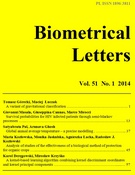
Biometrical Letters Vol. 51(1), 2014, pp. 45-56


As a result of intensive changes in plant production and of environmental changes in agrocenoses, certain agrophages, such as slugs, have in recent years been causing ever increasing amounts of damage to crops of agricultural, horticultural and orchard plants. As a result of the European Parliament and Council Directive adopted on 13 January 2009, the countries of Europe have been required to implement integrated plant protection. One of the principles of this protection is the implementation of strategies which minimize the use of chemical pesticides. Moreover, in accordance with decisions of the European Commission, many active substances have been or are to be withdrawn from the list of available pesticides. An example is metaldehyde, which is to be withdrawn from use in EU countries in the next few years (Commission Decision C/2008/7637 of 5 December 2008). It therefore becomes necessary to seek environmentally safe substances and to develop non-chemical methods for protecting plants against harmful slugs. An alternative to chemical molluscicides is the parasitic nematode Phasmarhabditis hermaphrodita. Studies have been made of the effectiveness of this biological method in combating Polish populations of the invasive slug species Arion lusitanicus. This was an incomplete multivariate study, i.e. not all variables could be observed for all treatments on all experimental units. Multivariate model of observations has been derived and a method of analysis has been described. The results of these studies provide a basis for the development of environmentally friendly methods of protecting plants against harmful slugs.

incomplete multivariate experiment, derived model of observations, estimation, integrated plant protection

